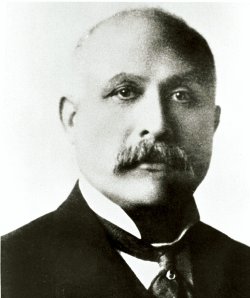Anthony Francis Lucas facts for kids
Quick facts for kids
Antun Lucas
|
|
|---|---|

Anthony Francis Lucas
|
|
| Born | September 9, 1855 |
| Died | September 2, 1921 (aged 65) Washington, D.C., U.S.
|
| Resting place | Rock Creek Cemetery Washington, D.C., U.S. |
| Nationality | Croatian/American |
| Scientific career | |
| Fields | Mechanical engineering |
Anthony Francis Lucas (born Antun Lučić; September 9, 1855 – September 2, 1921) was an American oil explorer who was born in Croatia. He is famous for helping to drill the oil well known as Spindletop near Beaumont, Texas. This discovery was a huge step for the oil industry and helped start the "Petroleum Age."
Contents
Early Life and Education
Anthony Lucas was born in Split, which was part of the Austrian Empire at the time. His family later moved to Trieste. When he was 20, Lucas finished his studies at the Polytechnical Institute in Graz, Austria. He became an engineer. After more training, he joined the Austro-Hungarian navy as a second lieutenant in 1878.
Moving to the United States
In 1879, Lucas visited his uncle in Saginaw, Michigan. He started working in a sawmill there, where he improved a type of saw. By 1883, he was working in the mining industry, looking for gold, copper, silver, and iron in places like Colorado and California.
He officially changed his name to Anthony Francis Lucas and became an American citizen in 1885. In 1887, he married Caroline Weed Fitzgerald. They moved to Washington, D.C. in 1888, where Lucas worked as an engineer.
A Career in Mining and Oil
In 1893, Lucas became the superintendent of a salt mine in Louisiana. He spent three years fixing the mine and getting it working again.
While working with salt, Lucas learned a lot about how salt deposits are connected to sulfur, natural gas, and oil. He realized that oil often gathered around large salt formations, called salt domes. This discovery made him want to look for oil in other areas. By 1898, he was an expert on salt domes.
The Famous Lucas Gusher
In 1899, Lucas visited a place called Sour Spring Mound near Beaumont, Texas. This spot would later become the famous Spindletop oil field. Lucas noticed that the ground looked like a small dome, and there was a gas smell. He thought this might mean there was sulfur or oil underground. He then made agreements to drill there.
Lucas started drilling in late 1899, using a special type of drilling rig that used a rotating drill. He drilled down about 250 feet (76 meters) and found a layer of oil sand.
He needed more money to keep drilling. He got help from John H. Galey and James M. Guffey, who found funding from Andrew Mellon. Lucas also kept a share of the deal. They hired the Hamill brothers to do the drilling.
On January 10, 1901, after drilling to a depth of 1,139 feet (347 meters), something amazing happened. Mud and water shot out of the well, followed by a huge stream of crude oil! This was the "Lucas Gusher." The oil shot up about 150 feet (46 meters) into the air. For nine days, the well flowed with an incredible amount of oil, between 70,000 and 100,000 barrels each day, before they could finally get it under control.
The discovery at Spindletop turned Beaumont into a "boomtown," meaning it grew very quickly. Lucas later sold his share in the oil company and continued to search for oil in other parts of the United States and Mexico.
Lasting Impact
The Lucas Gusher changed how the world used fuel and greatly boosted the economy of southeast Texas. It also helped the development of cars, which needed a lot of fuel. The city of Houston became a major center for the oil industry, and the United States became the world's top oil producer.
Anthony Francis Lucas is seen as the founder of modern petroleum reservoir engineering, which is the science of understanding and managing oil and gas fields. He later worked as a consultant in many countries, including Romania, Russia, Mexico, and Algeria. He was also the lifelong chairman of the American Committee for Oil and Gas.
Inventions and Contributions
Anthony Lucas developed many important ideas and tools that are still used in oil exploration and extraction today. Some of his contributions include:
- A special way of mining salt underground.
- Methods for finding mineral deposits from the surface.
- Using steam-powered, hydraulic-rotary drilling rigs and mud when drilling oil wells.
- Designing and using a special valve to control pressure.
- Creating blowout preventers, which stop uncontrolled oil flows.
- Developing well logs, which are records of what's found in a well.
- Inventing the "Christmas tree oil well," a system of valves and pipes at the top of an oil well.
His Heritage and Recognition
Anthony Lucas passed away on September 2, 1921, in Washington, D.C.. He was often mistakenly called Austrian or Italian. However, on his grave in Rock Creek Cemetery, it says he was of "Illyric" origin, which was a term used for Croatians at that time.
In 1936, the American Institute for Geological and Metallurgical Investigations created the Anthony F. Lucas Gold Medal to honor his work in oil exploration. A museum and a granite monument were built to remember him. A street and an elementary school in Beaumont, Texas, are also named after him.


